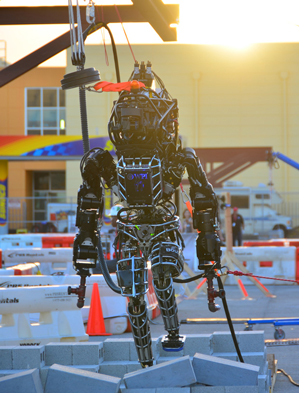DARPA’s Robot Challenge May Equip Robots to One Day Walk Among Us
Few people ever need to deal with a stricken nuclear reactor, but that skill could turn out to be important for the evolution of smarter robots.

In Pomona, California, this week, 25 of the world’s most advanced humanoid robots will take part in a contest inspired by the challenge of stabilizing a nuclear reactor that’s leaking dangerous radioactive material. Teams from universities across the U.S., as well as Japan, China, and Europe, are bringing robots that will try to walk across piles of rubble, climb ladders, operate power tools, and drive buggies, among other chores. Each challenge is inspired by something that might have helped stabilize the Fukushima Daiichi nuclear plant in Japan after it was damaged by an earthquake in 2011.
Considerable academic kudos will go to whichever team completes the most tasks within the allotted time by the end of the contest. But the event, called the DARPA Robotics Challenge (DRC), could also have repercussions across the robotics industry by encouraging the development of techniques that will let robots behave reliably and quickly within complicated and messy environments. The event is the second part of a two-stage event organized by U.S. Defense Advanced Research Projects Agency, a division of Defense Department tasked with exploring far-out technologies. The first stage was held in Miami, in December 2013, where robots faced the same challenges, and where slower teams were eliminated.
Many of the skills the robots will require—especially vision, balance, and object manipulation—are fundamentally important for countless everyday tasks. So the event might lead directly to more capable manufacturing robots, and could perhaps spur progress toward machines that can help out in hospitals or around the home.
Jerry Pratt, a senior research scientist at the Institute for Human and Machine Cognition in Florida, leads one of the most successful teams from the last DARPA challenge. He sees the event as just the beginning of a much bigger effort to make machines more useful. “Robotic skills that will be useful include things like loading a dishwasher, doing laundry, preparing food, cleaning a house, inspecting a factory,” Pratt says. “Many of these tasks will require skills beyond those for the DRC, and the environments will be much less structured. But the DRC represents the beginning steps to get to these goals.”
Many of the robots that will be on show in Pomona use techniques for balancing and walking that have only recently emerged from research labs. Some will also use a cutting-edge machine-learning approach known as deep learning in order to identify objects accurately and grasp them securely.
Although robots are commonplace in some industries, these machines only work within very controlled and regimented settings. In an unfamiliar setup, which requires improvisation and adaptation, something as seemingly simple as picking up a cup from a table can be very difficult for a robot to do. “Robustly interacting with objects in the real world is still a big challenge,” says Richard Mahoney, director of the robotics program at SRI, a research company based in Menlo Park, California. “For robots to be used in personal settings, they need to be able to handle the variability of our everyday environment.”
The hardware on show in Pomona will certainly be far more expensive than most industrial systems, not to mention existing home robots like the Roomba vacuum cleaner. A humanoid robot called Atlas, which is being used by several teams involved, costs more than a million dollars. Atlas was developed with military funding by a company called Boston Dynamics, which was among several robotics businesses acquired by Google shortly before the first DARPA event (see “Google’s Robot Recruits Dominate DARPA’s Rescue Challenge”). Google’s interest in robotics may reflect a belief that much more capable robots aren’t far away.
At the Pomona event, robots will be operated remotely, but they will need to be capable of some autonomy. A robot might be commanded to grasp a particular object, for example, but it could then formulate its own strategy for doing so. This mixed approach is partly for the sake of speed, but is also needed because communications connections will be throttled and occasionally shut down (to simulate the radio interference caused by a radiation leak). More sophisticated manufacturing robots could also employ partial automation.
Mahoney believes that far more advanced robots are on the way, partly thanks to research being driven by the DARPA challenge, but also because of demand for more flexible robots in industry. “I think manufacturing is really the beachhead for the service industry,” he says. “We’ll see robots start to do simple jobs in service environments in the next five years,” he says.
It could be a while longer before sophisticated robots start helping with household chores, however. Pratt says robots need to develop a much better sense of touch, and will need to be far safer and cheaper before that could happen. “It’ll happen,” he says. “We live in the century of the humanoid robot. But the big question is, what decade [will it happen]?”
Keep Reading
Most Popular
Large language models can do jaw-dropping things. But nobody knows exactly why.
And that's a problem. Figuring it out is one of the biggest scientific puzzles of our time and a crucial step towards controlling more powerful future models.
How scientists traced a mysterious covid case back to six toilets
When wastewater surveillance turns into a hunt for a single infected individual, the ethics get tricky.
The problem with plug-in hybrids? Their drivers.
Plug-in hybrids are often sold as a transition to EVs, but new data from Europe shows we’re still underestimating the emissions they produce.
Google DeepMind’s new generative model makes Super Mario–like games from scratch
Genie learns how to control games by watching hours and hours of video. It could help train next-gen robots too.
Stay connected
Get the latest updates from
MIT Technology Review
Discover special offers, top stories, upcoming events, and more.